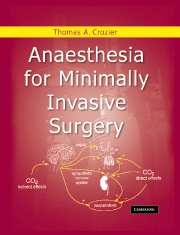Book contents
- Frontmatter
- Contents
- Preface
- Foreword
- Acknowledgements
- 1 Introduction
- 2 Physiology
- 3 Preparing and positioning for laparoscopic surgery
- 4 Monitoring
- 5 Anaesthesia for laparoscopic surgery
- 6 Complications and contraindications of laparoscopic surgery
- 7 Post-laparoscopy pain and pain relief
- 8 Laparoscopic bariatric surgery
- 9 Minimally invasive thoracic surgery
- 10 Laser surgery of the upper aerodigestive tract
- 11 Minimally invasive neurosurgery
- Index
6 - Complications and contraindications of laparoscopic surgery
Published online by Cambridge University Press: 21 October 2009
- Frontmatter
- Contents
- Preface
- Foreword
- Acknowledgements
- 1 Introduction
- 2 Physiology
- 3 Preparing and positioning for laparoscopic surgery
- 4 Monitoring
- 5 Anaesthesia for laparoscopic surgery
- 6 Complications and contraindications of laparoscopic surgery
- 7 Post-laparoscopy pain and pain relief
- 8 Laparoscopic bariatric surgery
- 9 Minimally invasive thoracic surgery
- 10 Laser surgery of the upper aerodigestive tract
- 11 Minimally invasive neurosurgery
- Index
Summary
Laparoscopic operations carry a distinct risk of complications despite their minimal invasiveness, as shown in Table 6.1. In one study, the incidence of typical anaesthesiological complications, such as hypo- or hypertension, tachycardia, hypercapnia, dysrhythmia, hypoxaemia or hypothermia, in the course of laparoscopic cholecystectomy was 19.8% compared to 14.8% with open cholecystectomy, but 3.7% with short gynaecological laparoscopic procedures. The most frequent complication during laparoscopic cholecystectomy was hypotension, which was seen in 13% of the patients. Arterial hypertension is a regular occurrence and most reviews do not even count it as a complication. Hypothermia, nausea and vomiting, hypoxaemia and pain head the list of the postoperative adverse events (Table 6.2). Subcutaneous emphysema, the incidence of which depends on the type of operation, is a typical surgical complication of laparoscopic operations that can have considerable anaesthetic implications in the postoperative period. The most important complications will be described and discussed in the following chapters.
Gas embolism
Intravascular gas embolism is one of the most serious complication of laparoscopic surgery. Depending on the gas used for insufflation, the speed of entrainment, the volume of gas entering the blood stream and the anaesthetic, the clinical impact of this complication ranges from a virtually inapparent course to death on the table. The incidence and the severity of gas embolism also depends on the type of endoscopic operation performed. Besides being aware of the factors that lead to embolization, the anaesthetist must also be well acquainted with those that aggravate the clinical effects of a gas embolism once it has occurred.
- Type
- Chapter
- Information
- Anaesthesia for Minimally Invasive Surgery , pp. 75 - 92Publisher: Cambridge University PressPrint publication year: 2004



